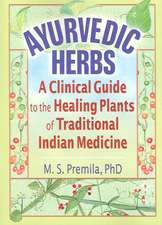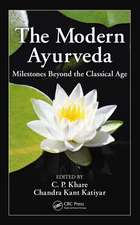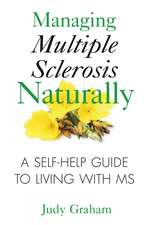Natural Posture for Pain-Free Living: The Practice of Mindful Alignment
Autor Kathleen Porteren Limba Engleză Paperback – 22 iul 2013
Preț: 129.60 lei
Preț vechi: 182.88 lei
-29% Nou
24.80€ • 25.89$ • 20.52£
Carte disponibilă
Livrare economică 21 martie-02 aprilie
Livrare express 28 februarie-06 martie pentru 92.19 lei
Specificații
ISBN-10: 1620550997
Pagini: 320
Ilustrații: b&w illustrations throughout
Dimensiuni: 203 x 254 x 18 mm
Greutate: 0.66 kg
Ediția:2nd Edition, New Edition of Ageless Spine, Lasting Health
Editura: Inner Traditions/Bear & Company
Colecția Healing Arts Press
Notă biografică
Kathleen Porter is the director of the Center for Natural Alignment in Portland, Oregon. She offers programs for people with posture-related pain and for children and teachers in classrooms. She has taught principles of natural alignment at the University of Hawaii at Hilo, the National College of Natural Medicine in Portland, Oregon, and the Omega Institute in Rhinebeck, New York. She lives in Portland, Oregon.
Extras
DESIGN FOR LIFE
Who is more fit? Is it a small woman with elastic muscles and naturally aligned bones or a much larger man with six-pack abs and firmly developed pecs, deltoids, and biceps?
The small woman is able to carry heavy rocks on her head all day long, day after day, without strain. Because the weight of the load is distributed through aligned bones, the bones actually do the work of carrying the load. Her muscles are thus free to perform their primary job of moving the bones without strain. The musculoskeletal system functions as a dynamic interplay between bones and muscles that requires the bones to bealignedand the muscles to beelastic. This balanced interplay is the hallmark of true fitness.
This man is clearly strong in ways the woman is not. His power lies within his muscles alone, not in an overall integrated whole of fully functioning parts. The popular culture of fitness today is partly based on the idea that developed muscles are a requirement. Unfortunately, muscles that have been developed in this way are storehouses of contracted tension, making it difficult for them to lengthen and relax. This type of strength must be worked at continuously and is dependent on a regular maintenance routine. This man’s spine is shortened and compressed. His breathing is restricted because of a diaphragm that doesn’t move in a natural, efficient way. The range of motion of his shoulders and hips is greatly restricted. It is ironic that the strength he has worked so hard to acquire has also become a type of weakness.
The modern-day confusion about what constitutes authentic strength and natural, easy flexibility is at the root of most of the chronic pain experienced by millions of people every day. In the United States today, millions of people live with chronic aches and pain that severely limit their activities, affect their ability to work, cost them thousands of dollars in lost wages, and impair their enjoyment of life. Employers, insurance companies, and workers’ compensation funds pay billions of dollars each year for lost time on the job and benefits to injured employees.
Unnatural strength
- has its power in purposely developed muscles
- must be continuously worked at to be maintained
- limits the range of motion of the joints
- restricts elasticity of the diaphragm
- compresses the spine
Natural strength
- has its power in aligned bones
- is innate and reinforced in ordinary activities
- promotes natural, easy flexibility of joints
- elongates the spine
Whether pain is chronic and low level or severe and debilitating, it has become an enormous problem in our country. In fact, pain is so common that it has come to be considered a normal fact of life. The epidemic of chronic pain has given way to a new medical specialty--pain management--because it is assumed that, in many cases, pain is something one simply must learn to live with. Too often pain management relies on the use of prescription drugs that generate billions of dollars in profits for pharmaceutical companies, while driving a crippling addiction problem for millions of Americans.
The list of complaints is long and includes general unexplained lower back pain, hip and knee pain, arthritis, tendonitis, sciatica, fibromyalgia, plantar fasciitis, frozen shoulder, rotator cuff injury, herniated or bulging discs, degenerative disc disease, spinal stenosis, spondylolesthesis, temporamandibular joint disorder (TMJ), and chronic tension in neck and shoulder muscles. Much of this pain appears to beidiopathic, meaning it has no clear, discernible cause, making it difficult for doctors to know how to treat it. When asked what caused their pain, people will often say things such as “I shouldn’t have lifted that box of books” or “I’ve been running for twenty years, and my knees finally wore out” or “I’m not as young as I used to be.”
If any of these people knew what their bodies were actually telling them, they might respond with more accurate answers, such as “Bending to lift a box of books, my pelvis was tucked under, causing my spine to round and preventing my core from stabilizing my spine. This forced my back to strain rather than being able to rely on aligned bones working with the strength of my legs and arms to do the work.” Or, “Running for twenty years with misaligned bones has put persistent stress on my knees, causing the cartilage to wear out.” Or possibly, “This aging body is now paying the price for not living according to its natural design.”
It can be startling to discover that exercise in and of itself, and in spite of its obvious benefits, is seldom the solution for this kind of pain over the long run. In fact, because exercise can reinforce and embed unhelpful patterns of movement, it can, and often does, cause many people’s pain in the first place. Eventually we all pay the price if our bones have not been able to do the job of supporting us throughout the years.
Musculoskeletal pain is far less of a problem in some parts of the world, even in places where people do a lot of manual labor for years on end. The secret seems to be that some people never lose the biomechanical principles of the human design, something all healthy toddlers discover when first learning how to stand and walk.
In our popular quest for fitness and a culturally imposed standard of beauty, many of us unwittingly disregard the importance of skeletal alignment and create conditions that compromise our long-term health. A misaligned skeleton causes muscles that attach to the skeleton to either shorten or lengthen unnaturally. This creates chronic tension that restricts mobility of certain joints. It also impairs breathing, compresses vertebrae, puts pressure on and distorts the spinal cord (the primary neural pathway), and affects circulation. It would be hard to argue with the fact that all of these factors have far-reaching consequences for one’s health.
Cuprins
Foreword by Jean Couch
Preface
Acknowledgments
Introduction
Part One
A Body of Knowledge
1 Design for Life
2 Architecture in Flesh and Bone
3 The Core of Well-Being
4 Meet Your Feet
5 Wheels, Bells, and Puppet Strings
6 An Exploding Crisis in Children’s Health
7 Amazing Grace
8 Pregnant with Possibilities
9 In Fitness or in Health?
10 Beyond the Physical
Part Two
Putting It All Together
11 Down to Basics
How to Sit • How to Lean Back on a Backrest • How to Stand • How to Walk • Take Yourself for a Walk • How to Bend • Sitting Down and Bending to Sit • Getting Up from a Chair or Sit to Stand • Sitting to Meditate • Lying on Your Side • Sleeping and Resting on Your Back • The Ultimate in Relaxation
12 Yoga on the Axis
Chair Pose • Tree Pose • Triangle Pose (Modified) • Warrior II • Garden Gate Pose • Plank Pose • Sphinx Pose • Head-to-Knee Pose • Seated Spinal Twist • Relaxation--Corpse Pose
A Few Parting Thoughts
Resources
Notes
Index
Recenzii
“As a family physician treating my share of patients with back pain, neck pain, osteoporosis, and dysfunctional labor, I find this book instructive. Kathleen Porter’s observation of peoples around the world who retain their natural alignment, movement, and relaxation is a clear window into the healing of the chronic pain syndromes of our culture. More than that, her work has been personally transformative.”
“In Natural Posture for Pain-Free Living, Kathleen Porter powerfully portrays the extensive damage we do to our bodies when we lose connection to natural principles of body alignment. Rather than looking to surgery, medication, and infinite exercise technologies to find freedom from discomfort and pain, we need only learn to stand, sit, walk, and move the way we did as young children when we learned organically to let our bones support us. Porter offers an abundance of useful tools for returning to our natural wisdom and greater body fluidity.”
“This updated second edition is an instructive, comprehensive look at how we move unconsciously in ways that cause our bodies pain and injury. Kathleen Porter, who directs the Center for Natural Alignment in Portland, Oregon explains through photographs and exercises the ways a supple spine can help remedy much of what ails our stiff bones.”
“The book is amazingly understandable, beautifully designed for maximum ease of use, and contains lots of documentation that justifies Porter’s claims. I happened to be struggling with a knee strain when I read it, and applying a simple change to my stance, per Porter’s instructions, brought instant improvement.”
“Guidelines for daily activities including sitting, walking, sleeping, and safe yoga practice fill this user-friendly reference and resource. This helps the practitioner ease chronic muscle tension, combats chronic neck/shoulder/back pain, and improve everyday life.”
“Kathleen Porter’s book is a great companion for teaching for many other modalities, but I found her information exceptionally beneficial in regard to the active meditations I teach. Movement is obviously important, but conscious movement is not as obvious for most people.”
“Never before in the world of fitness has there been a more readable, groundbreaking, or seminal book than Natural Posture for Pain-Free Living. Through this revolutionary book, Kathleen Porter is about to rock your world!”
Descriere
Our bones are the framework of support for our bodies, much like the wall studs and beams of a house. Yet the alignment of the skeleton along the vertical axis of gravity is largely overlooked today, even by fitness experts and yoga teachers. In a culture of cocked hips, sauntering models, and slouching TV watchers, where “chin up, shoulders back, stomach in” is believed to be good posture, we have forgotten what healthy alignment looks and feels like--leading to chronic neck, shoulder, and back pain for millions. Sharing photographs from around the world of “gurus” of natural posture and authentic strength, such as women in their 80s who easily carry heavy loads on their heads and toddlers learning to walk, Kathleen Porter shows what natural skeletal alignment truly looks like. With insights based on the fundamental laws of physics and detailed full-color diagrams, she guides you through an understanding of the body’s naturally pain-free design. She explains that when the body is aligned as nature intended, your weight is supported by your bones rather than your muscles, allowing a blissful release from chronic muscular tension--which you may not even be aware you had. She offers 12 physical exercises to become mindful of your posture and discover healthy alignment of your pelvis, rib cage, shoulders, neck, and your body as a whole. Providing easy-to-follow instructions for mindful alignment during the most ordinary daily activities, even sleeping, as well as a chapter on practicing yoga safely, Porter shows how returning to our forgotten alignment from childhood can offer relief from chronic pain and tension and can provide easy flexibility, enduring strength, and vitality well into old age.


















